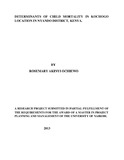| dc.description.abstract | The purpose of this study was to analyze factors that influence child mortality in Kochogo
location of Nyando District in Nyanza Province. Kochogo is situated in next to Ahero toen
and extends downwards touching the shores of Lake Victoria. The area has a well
developed infrastructural system interms of good access roads and well equipped health
facilities. The specific factors that were looked into were income levels of households,
education levels, access to heath facilities and cultural beliefs and practices. Towards this
accomplishment, the study targeted collecting data from household respondents in
Kochogo location of Nyando District. For the first set of respondents 1311 households
were identified as having children under 5 years of age but out of this only 20% were
sampled for interviews which translates to 260 households. This was then distributed
equally in Kochogo location. The study adopted purposive sampling technique to ensure
that all the significant groups were represented and their views included in the study
inferences. The research instruments adopted were semi structured questionnaires to allow
easier analysis and detailed exposition of issues under investigation. The questionnaires
were divided into 4 sections and each section gathered information based on the objectives
of this study. The study revealed that high levels of child mortality was common among the
caregivers who are totally illiterate with only primary school level of education and this
constituted 57% of all child mortality cases in this location. It was also realized that 76% of
child mortality cases were among those respondents in the informal sector which
experience unsteady flow of income. This was further confirmed by the fact that in this
area residents whose income is below Ksh. 3000 per month experience child mortality rates
of 56%. Accessibility to health facilities did not seem to influence child mortality in this
location. On cultural beliefs and practices, it came out clearly that those who hold on to
these practices experience more mortality cases than their counterparts who are modern. It
can therefore be concluded that child mortality is influenced directly by level of parental
education, income, cultural beliefs and practices but not accessibility to health facilities.
From this study it can be recommended that that the government and other stakeholders
should ensure the all citizens access compulsory education up to secondary school level,
secondly, there is need to initiate income generating activities that can create employment
opportunities to caregivers so as to increase their income base and finally, treatment costs
for children should be highly subsidized. There is need to conduct this study in other areas
apart form Nyando District and the need to monitor and evaluate efforts performed by
government and other stakeholders in the area of child health. | |

